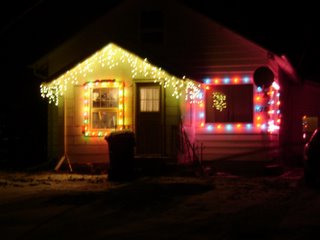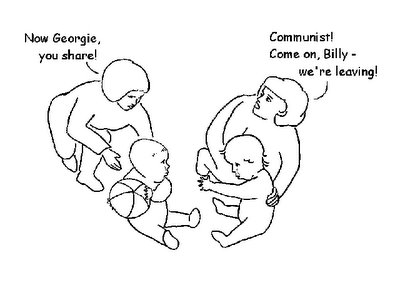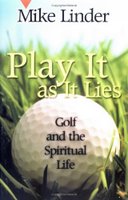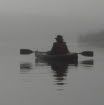. . . missing mousetraps, and . . . sniff-sniff-sniff - do I smell smoke?
I dread the missing mousetrap. I have been on trapline duty at the farm this fall, and for the most part I'm okay with that, but I quail at the sight of an empty spot where a trap should be. There is one trap site that is very effective, under the angle where a beam meets the floor, next to a side wall. It gives a perfect sheltered spot for a mouse to pause and check its surroundings for danger before giving its full attention to a feast of peanut butter.
There is almost always a mouse in that trap. Once in a while, though, the trap isn't there.
The first time it happened, there were little shavings of grey plastic littering the floor. I followed the trail of shavings and found the grey plastic mousetrap empty nearby, its perfectly molded plastic jaws now jagged with tiny toothmarks.
The second time was similar.
The third time, I stood by the trap site, scanning for the trap, and soon saw it resting at an odd angle, way across in the far corner of the room.
That corner was another trap site.
Before I got close, even though my mind was saying it couldn't be, I knew the truth: there was a mouse this time, and it was caught in two traps.
Its foreleg was caught in the grey plastic trap, which it must have dragged across the room. The other trap was fastened as a trap should be, firmly and lethally.
I wonder. Was this tableau a sign of great stupidity (or just typical stupidity, for a mouse)?
Or was it the record of a remarkably intelligent escape from suffering?
* * *
A couple of days later I decided to use the old truck to haul some things to town. I'd been warned about its quirky starting, so I pumped the gas as instructed, and the engine coughed, roared, sputtered, and died. This was typical, as I recalled, so I fired it up again, and then once more, and finally got it rolling. The farm dog galloped excitedly alongside as I gathered my load, jumping into the box the moment I stopped, and out again just as quickly when she remembered she hadn't had the "okay."
The south wind was bitter cold, and I was glad I had taken the time to find Dad's warm red hunting cap, quilted, with ear flaps, instead of the blaze-orange mass-market cap I'd been putting up with for deer season. I wondered if the dog was getting cold, but she seemed happy to trot back and forth nearby, checking out scent trails. Suddenly she dashed forward, intent on something under the truck. She raced around to the other side and then trotted triumphantly off with a mouse in her jaws. She played with it for a while, just like a cat, letting it go, batting it with her paws, dancing over it, pouncing, and finally clamping it in her mouth again and gazing off somewhere as if nothing special was happening.
I finished loading, drove back to the buildings, put my tools away, and paused to notice the dog once more. She was standing where the truck had originally been parked, eating something off the ground.
Dog food. Oh, those rodents. Her food bucket was in the shed nearby, and I guessed that something must have been stashing pellets under the truck. I didn't stop to wonder why such an exposed spot. My mind was on other food, for the kids, who would soon be arriving home (in town) for lunch.
I said farewell to the dog, got the truck started again, and during the trip down the lane, between episodes of purely sliding downhill on the icy patches, I tried to figure out the best route into town. Should I take the shortest way, and get there quicker to feed the kids, or should I take a slightly longer route around by the auction barn and the oilfield service yard, where nobody would care about the noisy old truck?
As I watched the exhaust spreading away from the road behind me, I was glad I had settled on the latter. That exhaust was awfully thick and white. Had the engine sputtering and dying been out of the ordinary, after all? I kept glancing at the gauges, not at all reassured by the fact that the oil light wasn't on. I couldn't hear the engine well over the rattling of the load. What to do?
Well, it's a very old truck. If I kill it by finishing the trip into town, it's no great loss.I settled into a slower speed, and the exhaust seemed to ease a little. By the time I passed the auction barn, it was looking almost normal - well, normal for a rusty old farm truck. I pulled into the yard as Ruth was leaving, on her way back to school. She had found herself a juice box and two cookies. That was her lunch.
James was still inside, standing by the kitchen table, still wearing his coat, with its hood up, and finishing a more substantial meal.
I sent him off, found some leftovers for myself, and spent the early afternoon unloading and puttering in the yard, until that raw south wind drove me inside to warm up. Towards supper time I walked downtown, and still the wind cut through my clothes. There was a hint of smoke in it, sometimes strong, and I thought about my friend who worried that his house would burn down while he was out working. The wind direction was right, but he would be at home today. Not to worry. Or should I worry more?
After supper, Ruth and I walked to the church for a choir rehearsal, of sorts. The main rehearsal is Sunday mornings now, to save people driving in on wintry roads at night (although right now, the snow is gone again). Thursday evenings I just go to the church and practise at the organ, and if somebody shows up I will help them with their singing, or play their favourite old hymns, or let them look through our music library and tell me what they like. Julianna came over to rehearse her solo for Sunday, and I polished up some hymns, and then we braved the wind once more.
As we stepped round the corner onto the driveway, I wondered out loud whose farm had the fire that had been stinking all day. Ruth had noticed it too. We passed the old truck, and the smell disappeared.
Had I imagined it? We circled the truck, and sure enough, downwind the smell was strong. Ruth got nervous and started worrying about her room being the closest if it exploded. I shooed her inside, changed to my work coat, and went over the truck in detail.
No smell at all in the cab.
Nothing around the engine.
It was definitely worst around the back, but there was nothing much in the box. I ducked down and saw an actual curl of smoke from somewhere underneath.
I hurried back to the house for a flashlight. All the while my mind was running through what it could be, and who I could phone to ask what it could be, and whether it could get worse in a hurry. There was dry grass right next to the driveway, and always that knifing wind. No lights at Brian's house across the street. I could phone Mom and Dad, but I knew I'd only get Mom tonight, and I didn't want to worry her.
The flashlight made a shaft across the smoke, and I quickly zeroed in on the source. There was no tailpipe on the muffler, and its rear opening was milky white. Something was smouldering in there.
What to do? Who to phone? I finally thought of my sister. She assured me that water wouldn't hurt the muffler itself, and insisted that it couldn't be a hot fire after all these hours. We traded ideas about something to just cover the hole and smother it, until I hit on the idea of aluminum foil. A couple of wads did the trick.
Now I know why that dog food was scattered on the ground where the truck had been. I also know what burnt dog food smells like.
The only thing I don't know, is how I'm going to get it out of the muffler before I drive that truck back out to the farm.

 Advent? Waiting? Not at this house. Santa has landed and is hard at work (that's him on the roof there), even though it's still November. I guess he has to start earlier these days to get all that stuff delivered. But that's another post.
Advent? Waiting? Not at this house. Santa has landed and is hard at work (that's him on the roof there), even though it's still November. I guess he has to start earlier these days to get all that stuff delivered. But that's another post.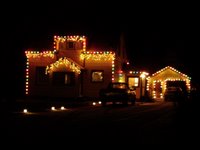 So far it's just individual properties that are decorated, but soon the town workers will be hanging an array of tinsel-and-light figures above the streets, fastening the stars and candy canes to the permanent brackets on the power poles, and plugging each one into a handy outlet right there on each pole. I had never noticed how the power got to those lights, but last year one of those town workers showed me, when he happened along as I was struggling with extension cords for my own string of Christmas merriment. I had draped a string of clear lights along the front hedge as a concession to the custom, letting it do double duty as a light source for the sidewalk where it passes my yard. He joked that I could just run my extension cord right from the power pole, and it wouldn't matter, because SaskPower doesn't charge the town for the extra electricity for Christmas lights.
So far it's just individual properties that are decorated, but soon the town workers will be hanging an array of tinsel-and-light figures above the streets, fastening the stars and candy canes to the permanent brackets on the power poles, and plugging each one into a handy outlet right there on each pole. I had never noticed how the power got to those lights, but last year one of those town workers showed me, when he happened along as I was struggling with extension cords for my own string of Christmas merriment. I had draped a string of clear lights along the front hedge as a concession to the custom, letting it do double duty as a light source for the sidewalk where it passes my yard. He joked that I could just run my extension cord right from the power pole, and it wouldn't matter, because SaskPower doesn't charge the town for the extra electricity for Christmas lights. I guess I shouldn't be surprised, considering that SaskPower is the title sponsor of the Festival of Lights in Regina. That has irritated me for years. Winter evenings are the peak demand time for electricity, and here is our power utility promoting even higher demand by sponsoring light festivals and giving away free lighting power to municipalities. I seem to recall inquiring about this conflict, and being told that Christmas lighting is not a significant issue for power conservation.
I guess I shouldn't be surprised, considering that SaskPower is the title sponsor of the Festival of Lights in Regina. That has irritated me for years. Winter evenings are the peak demand time for electricity, and here is our power utility promoting even higher demand by sponsoring light festivals and giving away free lighting power to municipalities. I seem to recall inquiring about this conflict, and being told that Christmas lighting is not a significant issue for power conservation. It's also interesting that I can't find any website promoting this year's Festival of Lights, except for a brief mention on a single calendar of major Saskatchewan events. As of today, both SaskPower and the Regina Chamber of Commerce are silent about it. What's happening? Did someone finally begin to feel a twinge of conscience?
It's also interesting that I can't find any website promoting this year's Festival of Lights, except for a brief mention on a single calendar of major Saskatchewan events. As of today, both SaskPower and the Regina Chamber of Commerce are silent about it. What's happening? Did someone finally begin to feel a twinge of conscience?